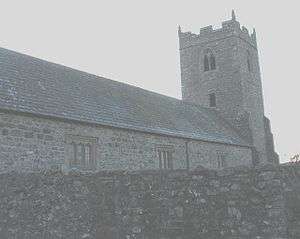Einion Frenin
Saint Einion Frenin (Welsh: old Enniaun, mod. Sant Einion or Engan Frenin, lit. "Saint Einion the King"; Latin: Ennianus or Anianus[1]) was a late 5th-[2] and early 6th-century[3] Welsh confessor and saint of the Celtic Church. His feast day was originally given as 9 February, although this had moved to the 10th or 12th by the 16th century[1] and is no longer observed by either the Anglican[4] or Catholic church in Wales.[5]
Saint Einion the King | |
|---|---|
 The 15th-century Llanengan church holding Einion's remains | |
| King of Llŷn | |
| Died | 6th century |
| Canonized | Pre-Congregation |
| Major shrine | Llanengan |
| Feast | 9 February (lapsed) |
| Patronage | Llanengan |
Life
Saint Einion was a son of Owain Whitetooth (Ddantgwyn) and the brother of Cuneglas, king of Rhos, and of saints Seiriol and Meirion.[6][9] Part of Gwynedd's Cuneddan dynasty, he seems to have ruled as a local king (Latin: regulus) over the Llŷn Peninsula southwest of Anglesey and possibly over Anglesey itself.[1][10][11] He was credited with granting his brother Seiriol the land for his monastery (Welsh: clas) at Penmon on Anglesey[1] and, later, his hermitage on Puffin Island.[12] He also lured the Breton saint Cadfan from Tywyn to found St Mary's Abbey, the first religious establishment on Bardsey Island.[1] Although not part of the Cistercian Way, this became a major site of pilgrimage in Wales. Einion himself is sometimes said to have joined Cadfan's community on the island,[13] although his relics were claimed by the church at Llanengan.[1]
Legacy
Einion Frenin was credited with the establishment of the original church at Llanengan (St Einion's).[1] The present church there, which was erected in the late 15th or early 16th century,[2] had a gilt and crowned statue of him prior to the Reformation[14] and bears Latin inscriptions reading Æniani Rex Wallie and Rex Walliæ ("Einion, king of Wales"). Miraculous locations nearby include Ffynnon Engan ("Einion's Well") and Ol Troed March Engan ("The Hoofprint of Einion's Horse"), a petrosomatoglyph near Castell Cinan whose collected rainwater was claimed to possess curative powers.[1] Other placenames possibly related to the king are Ogo' Engan ("Einion's Cave"), Bryn Engan ("Einion's Hill"), Caer Engan ("Engan's Camp"), and Croes Engan ("Einion's Cross"), a farm in Denbighshire.[1]
Llandogo in Monmouthshire was also sometimes previously known as Lann Enniaun ("Llanennion") and the bard Hywel Rheinallt composed a cywydd to the "golden-handed" Saint Einion in the late 15th century, recording another (now unknown) church in Gwynedd dedicated to St Einion.[1]
See also
- Einion, for other Welshmen of the same name
References
- Baring-Gould, Sabine & al. The Lives of the British Saints: The Saints of Wales and Cornwall and Such Irish Saints as Have Dedications in Britain, Vol. II, pp. 422 ff. Chas. Clark (London), 1908. Hosted at Archive.org. Accessed 18 Nov 2014.
- Abersoch Virtual Guide. "History: The Pilgrim's Trail and Some of Its Churches". Accessed 18 Nov 2014.
- Carlisle, Nicholas. A Topographical Dictionary of the Dominion of Wales, p. 305. W. Bulmer & Co. (London), 1811.
- The Church in Wales. "The Book of Common Prayer for Use in the Church in Wales: The New Calendar and the Collects". 2003. Accessed 18 Nov 2014.
- The Catholic Church in England and Wales. "Liturgy Office: February 2015". Catholic Bishops' Conference of England and Wales, 2014. Accessed 18 Nov 2014.
- Baring-Gould, Sabine & al. The Lives of the British Saints: The Saints of Wales and Cornwall and Such Irish Saints as Have Dedications in Britain, Vol. III, p. 460 Archived 29 November 2014 at the Wayback Machine. Chas. Clark (London), 1908. Hosted by Forgotten Books (London), 2013. Accessed 18 Nov 2014.
- Thomas, John. The Myvyrian Archaiology of Wales, Part 1, p. 424. T. Gee, 1870. Accessed 18 Nov 2014.
- Peter, David. Hanes Crefydd yn Nghymru [The Ecclesiastical History of Wales], p. 152. J. Evans (Heol-y-Farchnad), 1816. Accessed 18 Nov 2014. (in Welsh)
- He was also formerly given as the son of Einion Yrth.[3][7][8]
- Pennick, Nigel (1996). Celtic Sacred Landscapes. Thames & Hudson. ISBN 0-500-01666-6
- Pennick, Nigel. Celtic Sacred Landscapes. Thames & Hudson, 1996. ISBN 0-500-01666-6.
- Topham, Simon. "Ynys Seiriol Archived 29 November 2014 at the Wayback Machine". Mysterious Britain and Ireland. Accessed 18 Nov 2014.
- Bardsey Island Trust. "The Early Saints Archived 17 July 2014 at the Wayback Machine". Bardsey Office (Pwllheli), 2014. Accessed 18 Nov 2014.
- Jones, T. Thornley. "The 'Llannau' of Cwmdauddwr Parish" in The Transactions of the Radnorshire Society, Vol. XXXVI, pp. 18–19. Radnorshire Society, 1966. Hosted at the National Library of Wales (Aberystwyth), 2009. Accessed 18 Nov 2014.